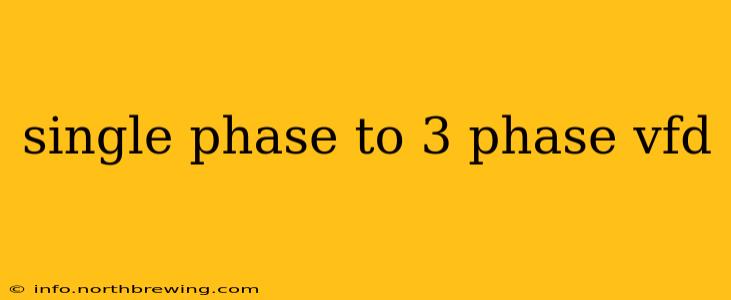Many industrial and commercial applications rely on three-phase motors for their robust performance and efficiency. However, not all locations have access to a three-phase power supply. This is where single-phase to three-phase VFDs (Variable Frequency Drives) step in, offering a cost-effective solution to power three-phase motors using a readily available single-phase power source. This comprehensive guide explores the intricacies of these devices, answering common questions and addressing key considerations.
What is a Single-Phase to Three-Phase VFD?
A single-phase to three-phase VFD is a type of power electronic converter that transforms a single-phase AC power input into a three-phase AC output. This output is then used to control the speed and torque of a three-phase AC induction motor. Unlike a standard VFD that works directly with a three-phase supply, this specialized unit incorporates an internal power conversion stage to create the necessary three-phase power from a single-phase source. This makes it ideal for situations where three-phase power is unavailable or impractical to install.
How Does a Single-Phase to Three-Phase VFD Work?
The heart of a single-phase to three-phase VFD lies in its ability to synthesize a three-phase waveform from a single-phase input. This is achieved through a combination of:
- Rectification: The single-phase AC input is first rectified to produce a DC voltage.
- Inverter: A sophisticated inverter circuit then converts this DC voltage back into a three-phase AC voltage using pulse-width modulation (PWM) techniques. The PWM technique precisely controls the switching of transistors to create the desired three-phase waveforms.
- Output Filtering (Optional): Some VFDs incorporate output filters to further refine the synthesized three-phase waveform, improving the motor's performance and reducing harmonic distortion.
This process effectively simulates a three-phase power supply, allowing the three-phase motor to operate smoothly and efficiently.
What are the Advantages of Using a Single-Phase to Three-Phase VFD?
- Cost-Effectiveness: Installing a new three-phase power supply can be expensive and complex. Using a single-phase to three-phase VFD provides a much more economical solution.
- Flexibility: It allows the use of three-phase motors in locations with only single-phase power availability.
- Motor Speed Control: Similar to standard VFDs, these units enable precise control over motor speed and torque, leading to improved efficiency and process optimization.
- Reduced Energy Consumption: Precise speed control can reduce energy waste compared to running a motor at a fixed speed.
- Soft Starting: They typically offer soft-starting capabilities, reducing mechanical stress on the motor and connected equipment.
What are the Disadvantages of Using a Single-Phase to Three-Phase VFD?
- Higher Initial Cost: While often cheaper than installing three-phase power, the initial cost of a single-phase to three-phase VFD is generally higher than a standard VFD.
- Lower Power Capacity: They typically have lower power ratings compared to their three-phase counterparts for a given physical size.
- Harmonic Distortion: Although output filtering helps mitigate this, some harmonic distortion can still be introduced into the power system.
- Increased Heat Generation: The power conversion process generates heat, requiring adequate cooling.
What Size Motor Can a Single-Phase to Three-Phase VFD Handle?
The motor size that a single-phase to three-phase VFD can handle depends on its power rating. These VFDs are typically available in various sizes, ranging from small fractional horsepower motors to several horsepower motors. It's crucial to select a VFD with a power rating sufficient for the motor's requirements, taking into account the motor's full-load current and voltage. Always consult the VFD's specifications and the motor's nameplate data to ensure compatibility.
Can I Use Any Single-Phase to Three-Phase VFD with Any Three-Phase Motor?
No. It's crucial to match the VFD's specifications (voltage, frequency, power rating) with the motor's nameplate data. Using an incompatible VFD can damage the motor or the VFD itself. Proper motor selection and VFD sizing are critical for safe and reliable operation.
What are the Applications of Single-Phase to Three-Phase VFDs?
Single-phase to three-phase VFDs find application in various scenarios where three-phase power isn't readily available, including:
- Small Industrial Machinery: Operating smaller three-phase pumps, compressors, or conveyors in workshops or factories with only single-phase power.
- Agricultural Applications: Controlling irrigation pumps or other equipment in rural areas with limited power infrastructure.
- Commercial HVAC Systems: Regulating the speed of three-phase air conditioning or ventilation fans.
- Residential Applications (limited): In some specific cases, like controlling a larger three-phase well pump, but this is less common.
This technology offers a versatile and adaptable solution for a wide range of applications where the limitations of single-phase power would otherwise restrict the use of highly efficient three-phase motors. Careful planning and consideration of the specific application requirements are key to successful implementation.
